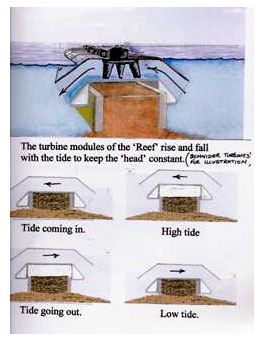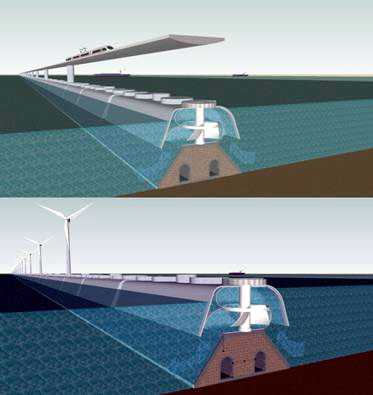How to get renewable energy from the tides in the Severn without damaging the environment Peter Bunyard
The Severn estuary has long attracted the attention of engineers and various governments, who see the ebb and flow of its tides – reckoned to be third highest tidal range in the world - as a potential major contributor to the UK’s use of renewable energy. By building a barrage across the estuary, engineers estimate that the 7 to 8 metre average tidal range could provide up to 5 per cent of the UK’s electrical energy, with up to 8 gigawatts (GW) being generated at low tide when the water from the high tide has gathered behind the dam. According to the Department for Business Enterprise & Regulatory Reform (BERR), total primary energy consumption in the UK in 2007 was about 230 million tonnes of oil equivalent [1], with electricity consuming at least one third. On the basis of the barrage generating a 24 hour average of 2 GWs, and, as 1 Mtoe is 11.630 GWh, it would yield 17 520 GWh/y, about 0.65 percent of UK’s total primary energy and 2 per cent of total electricity [2]. That is under half the 5 per cent claimed by the Chartered Institution of Water and Environmental Management which has stated that the barrage would pay back its carbon footprint in construction in no more than 6 months [3].
Yet, since the Severn Barrage scheme estimated to cost £15 000 million was first proposed many decades back, it has triggered environmental concerns among a wide range of groups. A 2008 report [4], commissioned from Frontier Economics by the Royal Society for the Protection of Birds (RSPB), WWF-UK, the Anglers’ Conservation Association, the National Trust, as well as fishery interests, such as the Wye Salmon Fishery Owners’ Group, concluded that the costs of the barrage could not be justified on economic grounds, let alone on the grounds of the environmental devastation that its construction and operation would cause.
In its final form, and after a massive undertaking, the Severn Barrage would not only have to be big enough to extract the potential energy from the tidal head of 8 metres or more, it would also have to cope with powerful weather events, such as storm surges, and even sea level rise, now projected to be faster than estimated a few years ago. Electricity would be generated by a series of 40 megawatt underwater turbines during the two extremes of the tide. This would put a considerable strain on the central grid, which would have to cope with large surges in generation at times that while predictable are not controllable.
As pointed out in the Frontier Economics report, the barrage would inevitably lead to the loss of hundreds of square kilometres of mudflats and salt marsh, home to waders and other coastal birds as well as to a host of migratory species. Furthermore, on account of the delay in the natural tidal rhythm from penning in the water and then from the surge of water over each of the turbines when the gates are opened, its construction and use would alter drastically the currents in the estuary, playing havoc with the deposition of silt and having a profound impact on estuarine life, including fisheries and salmon runs.
Cornish hydraulics engineer Rupert Armstrong Evans believes the Cardiff-Weston Barrage across the Severn Estuary (as currently planned) is massively ill-conceived [5]. Instead, he has proposed a substantially different concept that he claims would generate as much electricity, but far more steadily than the big barrage and would have a much reduced environmental impact. In particular, it would leave most of the mudflats and salt marsh intact.
Having pioneered electronic control systems that revolutionised the use of mini-hydro in the 1970s; and installed low-head hydraulic turbines which he designed for use in different parts of the world, from Cornwall, Wales, Scotland, to Nepal, India and South America, Rupert has come up with the innovative idea of a structure that has parallels with a tidal reef and so is designed to extract the energy from no more than two metres of tidal head
In his tidal reef concept, Rupert proposed a semi-floating set of caissons (water-tight structures) to stretch across the estuary, thereby avoiding the massive high-head structure implied in the construction of the Severn Barrage. The fundamental difference between the barrage and reef is that, in the latter, the 1 000 turbines of some 10 metres in diameter would be housed within the floating caissons, themselves designed to ride over a fixed base reef on the estuary floor. By using a moveable ‘crest gate’ to track the tide level and therefore to maintain a small head difference, irrespective of the stage of the tide, the turbines would operate for long periods, and for at least double the generation period compared to the proposed big barrage. In addition, the reef would be far less vulnerable under adverse conditions than the barrage, on account of its smaller size and lower operating 'head'. In that respect, storm surges would easily go over the structure rather than battering it, as would be the case for the barrage (see Fig. 1).

Figure 1. Cross section of the reef with caisson housing a turbine
On account of the structure being more modest than the barrage, the saving on rock fill alone would amount to more than 10 million tonnes. At the same time, the passage of ships would be easier, as a single gate, similar in principal to the Thames Barrier, would allow the passage of even the largest ships with minimal disruption. This is only possible because of the small head difference across the structure. This system would also avoid the need to dredge a new deep-water shipping channel.

Figure 2. Artist impression of tidal reef with road/rail link (above) or wind machines superimposed on the underlying structure.
As Rupert points out, migratory fish should have no problems navigating the slow-moving turbines, and with the low head required any changes to the estuary flows will be significantly reduced, causing far less impact on the mud banks and salt marshes than would the barrage. Moreover, the time taken to construct the reef would be considerably less than for the barrage. Rupert refers to an excellent precedent in the construction of the Mulberry Harbour floating dock that was put together for the D-day Normandy landings. The various pieces of the dock were built in six months, before being successfully installed under enemy fire.
Rupert has had the backing of WS Atkins, the international engineering consultancy which, in 2008, declared that Rupert’s Reef Scheme would not only generate more electricity but would cost considerably less – by some £2 000 million - while simultaneously avoiding the worst environmental aspects of the Severn Barrage [6].
In the face of mounting concerns over the ecological damage that would result from constructing the barrage across the Severn estuary, Rupert’s reef scheme has met with the approval of the RSPB. Furthermore, the government has just announced [7] that it believes the ‘Severn Tidal Power Reef’ project to have merit, and is to commit financial support towards its future development, thereby postponing, at least for a year, any decision as to which project it gives the go-ahead.
Article first published 30/03/09
Comments are now closed for this article